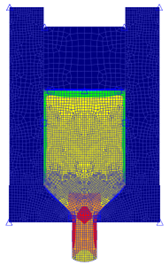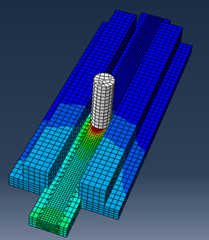
Harnessing the Power of Finite Element Analysis
Part 4: Heat Transfer Analysis
By Amin Moghaddas
Thermal analysis is the study of heat transfer and temperature changes within materials and systems. It enables engineers to model how heat flows, accumulates, or dissipates under various conditions. Controlling thermal behavior is essential in industrial applications, as it ensures structural integrity and optimal performance of components.

to minimize the chance of internal and surface
cracking of billet during hot extrusion
By integrating Finite Element Analysis (FEA), engineers can simulate, analyze, and optimize complex manufacturing processes that involve thermal effects. While thermal analysis focuses on heat flow, its true value emerges when paired with mechanical analysis to evaluate the combined effects of temperature and structural forces — commonly referred to as thermo-mechanical analysis. Figure 1 demonstrates an example of a thermo-mechanical model of an extrusion process developed using FEA, where the model was applied to optimize processing conditions to minimize the chance of cracking during hot extrusion process of a billet.
Among different applications that might require thermo-mechanical analysis, welding processes stand out as particularly challenging due to the high temperatures and rapid thermal cycles involved. Here, thermal analysis can provide critical insights into how heat affects the materials being joined. By integrating FEA, engineers can simulate and understand the complex thermal and mechanical phenomena that occur during welding, such as temperature distribution, distortion, and residual stress. Figure 2 shows an application of FEA to model friction stir welding process which has been used for optimization to reduce distortion and residual stress in the welded extruded samples.

In welding, the precise control and prediction of heat flow through materials are critical for achieving high-quality welds and avoiding potential failures. By simulating thermal behavior during and after welding, FEA enables engineers to:
- Understand temperature distribution: FEA maps out how heat propagates through the material, ensuring uniformity where needed and preventing overheating or under-heating.
- Predict distortion: Welding often leads to unwanted distortions that can affect assembly tolerances. With FEA, distortions can be quantified and minimized before physical welding begins.
- Analyze residual stress: Residual stress left in welded components can impact performance and longevity. FEA helps identify critical stress areas, enabling corrective measures in the design phase.
Implementing FEA for welding process analysis offers significant advantages:
- Cost Efficiency: Early detection of potential issues, such as cracking, excessive distortion or stress concentration, reduces the need for expensive rework and material waste. Figure 3 shows the application of FEA to model post-weld temper passes to control the hardness and minimize the chance of cracking in electron beam welding of gear assembly.
- Accelerated Development: Simulating the thermal processes virtually speeds up the product design cycle by reducing reliance on iterative physical testing.
- Improved Quality: Insight into thermal and mechanical behavior ensures consistent weld quality and enhances product reliability.

passes to control hardness and the chance of cracking
in electron-beam welding of gear assembly
Are you exploring ways to improve your welding processes or overcome challenges related to temperature control, distortion, or residual stress? Let’s discuss how FEA can help you achieve your goals with precision and efficiency. Contact [email protected].
Read other articles in this series:
- Part 1: Introducing Finite Element Analysis
- Part 2: Harnessing the Power of FEA: Structural Analysis
- Part 3: Harnessing the Power of FEA: Vibrational Analysis
Amin Moghaddas is an Applications Engineer in the EWI resistance and solid-state group with more than 15 years of expertise in Finite Element Analysis (FEA). His primary focus is computational modeling of thermal processes, specializing in predicting temperature profile, residual stress, and distortion. Amin also has deep expertise in vibration analysis, designing and fabricating tooling for ultrasonic systems. Additionally, he is highly skilled in the structural analysis of components, including both static and dynamic simulations.